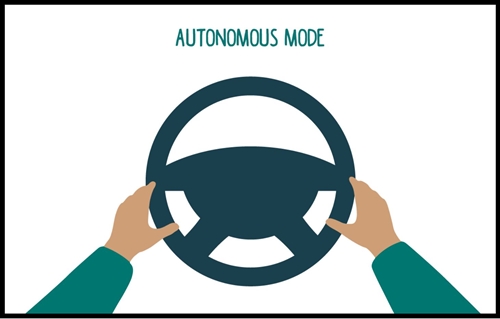 A prototytpe rolls through downtown Detroit in driverless mode, but with two front-seat riders for now. (Photos: Argo AI)
A prototytpe rolls through downtown Detroit in driverless mode, but with two front-seat riders for now. (Photos: Argo AI)Second of two parts. Part 1 is here.
Self-driving Ford Fusion Hybrids are guiding themselves through selected parts of Detroit, including the busy downtown rotary loop above.
Eventually, if all goes as planned, they and Ford vans will have no one behind the wheel -- though not anytime soon. Argo AI, the automaker's autonomous vehicle development partner, has two "highly trained" employees in the front seat on each public test drive.
Still, software is in control as the car steers, accelerates, brakes and avoids accidents. Each of the third-generation autonomous Fusions is back in manual mode when heading to and from Argo's regional engineering center in Allen Park, as well as in school zones and when emergency vehicles zip past with lights on.

Corktown is a digitally mapped testing area, as well as the future base for Ford Autonomous Vehicles LLC.
The Pittsburgh-based technology developer, which got a $1-billion investment from Ford in February 2017, also tests Fusions on public roads in four other places -- its home city, Miami, Washington, D.C., and Palo Alto, Calif.
Closed-course testing with inflatable pedestrians, fake dogs, remote-controlled skateboarders and robotic baby strollers is done earlier to check software, artificial vision and digital mapping systems. The goal is "Level 4" automation -- a system that drives under specific conditions without passenger supervision, a Society of Automotive Engineers (SAE) definition.
Scientist-like patience needed

"The technology remembers everything it sees and learns," Argo AI says.
Argo's website describes a "culture of safety" designed to "earn your trust and acceptance." Don't Worry, Be Happy is the implied soundtrack.
Self-driving cars have two huge advantages over people: the technology remembers everything it sees and learns, and lessons learned are shared across the fleet.
When we decide to test in any given city, Test specialists begin by manually driving through the city, gathering data to build three-dimensional maps of the streets where we intend to operate. Once the map is ready, we can begin testing in autonomous mode. . . .
We call them test specialists because their job requires an entirely new skillset, combining the instincts of race car drivers with the meticulous patience of scientists.
One specialist sits behind the wheel, ready to take over anytime. The other specialist monitors the software’s performance and advises of any situations that warrant their teammate taking control. . . .
Every day we're on the road, we see new and unusually complex interactions between road users that we wouldn’t have thought of on our own. The more information we collect, the more we can solve, and the safer our next iteration of software becomes.
In time, our self-driving system — always vigilant, always learning, never forgetful — will become a better driver than any human.

Though not operating the vehicle most the time, Argo test drivers are expected to have "hands hovering [near the steering wheel] at 8 and 4 o'clock — ready to take manual control at any time," as shown at left.
Heading off unsure scenarios

The driving "eyes" and sensors.
The startup, which has grown to more than 500 employees, also tells when testers turn off the autonomous mode.
The transition from autonomous test mode to manual mode is called a disengagement. There are two types of disengagements:
- Voluntary, in which a specialist chooses to take control.
- Involuntary, in which a specialist is required to take control.
We train test specialists to preemptively take control by anticipating situations where they may be required to do so. A cautious specialist will have many voluntary disengagements.
Some are even mandatory, based on policies we change as our software evolves. For example, our specialists are currently required to take manual control when traveling through a school zone or when they see a first-responder vehicle with emergency lights flashing.
We encourage our specialists to be cautious, because there is no upside to letting scenarios "play out" in the real world. Voluntary disengagement data is especially valuable for improving our simulations, where we can "play forward" scenarios our specialists preempted, and safely learn how our software would have reacted if they hadn't.
Drivers regain control by tapping the brake or gas pedal, or grabbing the wheel with pressure. ("It doesn't take much!")
A never-pushed button is red
There also are yellow and red center console buttons. The first disengages self-driving without stopping the car. The other "shuts down the entire self-driving system and the powertrain. No test specialist has ever had to use it, but it's there. Just in case."
Argo describes three-phase training for its road testers, dubbed "public ambassadors," and tells how it tries to keep them engaged:
- Specialists must take mandatory breaks at least every two hours.
- Specialists may swap seats anytime. Because people often know themselves better than any policy.
- Specialists swap teammates every day. We want our specialists to be friends, but we also don’t want familiarity to take off their edge.
- Specialists may take breaks anytime.
- Specialists may request a non-driving day anytime. Anyone can have a bad night, or not feel 100%. If so, we have lots of work at the garage or in the office at the garage.
- Random manager ride-alongs. Just to keep the teams on their toes.
The company's "How We Test" page ends on a humble note: "We've got a lot of work to do."
-- Alan Stamm
► Day One: Why Detroit's Challenging Streets Are Ideal for Driverless Car Tests by Ford's Partner










